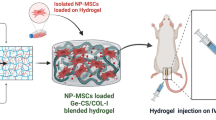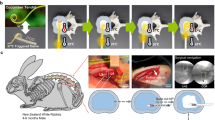Abstract
In degenerative disc disease, an injectable hydrogel can fill a degenerate area completely, reduce the risk of implant migration and subsequent loss of height of the intervertebral disc, and minimise surgical defects. Here, we propose a method of preparing an injectable silk fibroin/polyurethane (SF/PU) composite hydrogel by chemical cross-linking under physiological conditions. Mechanical testing was used to determine the mechanical strength of the hydrogel. The impact of hydrogel height on the biomechanical properties was discussed to estimate the working capacity of the hydrogel for further clinical application. Rheological properties were also examined to assess the practical ability of the hydrogel for clinical application. Hydrogel injection and cell assessment is also of interest for clinical application. An SF/PU composite hydrogel can be injected through a small incision. A cell proliferation assay using bone marrow stromal cells showed positive cell viability and increased proliferation over a seven-day period in culture. Importantly, the hydrogel can be monitored in real-time using X-ray fluoroscopy during and after surgery according to the results of X-ray fluoroscopy examination, and shows good visibility based on X-ray assays. In particular, the hydrogel offers the clinically important advantage of visibility in CT and T2-weighted magnetic resonance imaging. Based on the results of the current study, the SF/AU composite hydrogel may offer several advantages for future application in nucleus pulposus replacement.
















Similar content being viewed by others
References
Andersson GB. Epidemiological features of chronic low-back pain. Lancet. 1999;354(9178):581–5.
Leino PI, Berg MA, Puska P. Is back pain increasing? Results from national surveys in Finland during 1978/9–1992. Scand J Rheumatol. 1994;23(5):269–76.
Bressler HB, Keyes WJ, Rochon PA, Badley E. The prevalence of low back pain in the elderly. A systematic review of the literature. Spine (Phila Pa 1976). 1999;24(17):1813–9.
Ghiselli G, Wang JC, Bhatia NN, Hsu WK, Dawson EG. Adjacent segment degeneration in the lumbar spine. J Bone Joint Surg Am. 2004;86(A7):1497–503.
Phillips FM, Reuben J, Wetzel FT. Intervertebral disc degeneration adjacent to a lumbar fusion. An experimental rabbit model. J Bone Joint Surg Br. 2002;84(2):289–94.
Hilibrand AS, Robbins M. Adjacent segment degeneration and adjacent segment disease: the consequences of spinal fusion? Spine J. 2004;4(6):190S–4S.
Bao QB, McCullen GM, Higham PA, Dumbleton JH, Yuan HA. The artificial disc: theory, design and materials. Biomaterials. 1996;17(12):1157–67.
Gillet P. The fate of the adjacent motion segments after lumbar fusion. J Spinal Disord Tech. 2003;16(4):338–45.
Tibrewal SB, Pearcy MJ. Lumbar intervertebral disc heights in normal subjects and patients with disc herniation. Spine. 1985;10(5):452–4.
Studer A. Nucleus prosthesis: a new concept. EUR Spine J. 2002;11(Suppl 2):S154–6.
Selviaridis P, Foroglou N, Tsitlakidis A, Hatzisotiriou A, Magras I, Patsalas I. Long-term outcome after implantation of prosthetic disc nucleus device (PDN) in lumbar disc disease. Hippokratia. 2010;14(3):176–84.
Joshi A, Massey CJ, Karduna A, Vresilovic E, Marcolongo M. The effect of nucleus implant parameters on the compressive mechanics of the lumbar intervertebral disc: a finite element study. J Biomed Mater Res B Appl Biomater. 2009;90(2):596–607.
Thomas J, Lowman A, Marcolongo M. Novel associated hydrogels for nucleus pulposus replacement. J Biomed Mater Res A. 2003;67(4):1329–37.
Allen MJ, Schoonmaker JE, Bauer TW, Williams PF, Higham PA, Yuan HA. Preclinical evaluation of a poly (vinyl alcohol) hydrogel implant as a replacement for the nucleus pulposus. Spine (Phila Pa 1976). 2004;29(5):515–23.
Joshi A, Fussell G, Thomas J, Hsuan A, Lowman A, Karduna A, Vresilovic E, Marcolongo M. Functional compressive mechanics of a PVA/PVP nucleus pulposus replacement. Biomaterials. 2006;27(2):176–84.
Thomas JD, Fussell G, Sarkar S, Lowman AM, Marcolongo M. Synthesis and recovery characteristics of branched and grafted PNIPAAm-PEG hydrogels for the development of an injectable load-bearing nucleus pulposus replacement. Acta Biomater. 2010;6(4):1319–28.
Bergknut N, Smolders LA, Koole LH, Voorhout G, Hagman RE, Lagerstedt AS, Saralidze K, Hazewinkel HA, van der Veen AJ, Meij BP. The performance of a hydrogel nucleus pulposus prosthesis in an ex vivo canine model. Biomaterials. 2010;31(26):6782–8.
Boelen EJ, Koole LH, van Rhijn LW, van Hooy-Corstjens CS. Towards a functional radiopaque hydrogel for nucleus pulposus replacement. J Biomed Mater Res B Appl Biomater. 2007;83(2):440–50.
Boelen EJ, van Hooy-Corstjens CS, Bulstra SK, van Ooij A, van Rhijn LW, Koole LH. Intrinsically radiopaque hydrogels for nucleus pulposus replacement. Biomaterials. 2005;26(33):6674–83.
Bertagnoli R, Schonmayr R. Surgical and clinical results with the PDN prosthetic disc-nucleus device. Eur Spine J. 2002;11(Suppl 2):S143–8.
Klara PM, Ray CD. Artificial nucleus replacement: clinical experience. Spine (Phila Pa 1976). 2002;27(12):1374–7.
Jin D, Qu D, Zhao L, Chen J, Jiang J. Prosthetic disc nucleus (PDN) replacement for lumbar disc herniation: preliminary report with six months’ follow-up. J Spinal Disord Tech. 2003;16(4):331–7.
Bertagnoli R, Vazquez RJ. The Anterolateral TransPsoatic Approach (ALPA): a new technique for implanting prosthetic disc-nucleus devices. J Spinal Disord Tech. 2003;16(4):398–404.
Shim CS, Lee SH, Park CW, Choi WC, Choi G, Choi WG, et al. Partial disc replacement with the PDN prosthetic disc nucleus device: early clinical results. J Spinal Disord Tech. 2003;16(4):324–30.
Carl A, Ledet E, Yuan H, Sharan A. New developments in nucleus pulposus replacement technology. Spine J. 2004;4(6):325S–9S.
Korge A, Nydegger T, Polard JL, Mayer HM, Husson JL. A spiral implant as nucleus prosthesis in the lumbar spine. Eur Spine J. 2002;11(2):S149–53.
Meakin JR, Reid JE, Hukins DW. Replacing the nucleus pulposus of the intervertebral disc. Clin Biomech (Bristol, Avon). 2001;16(7):560–5.
Arthur A, Cannella M, Keane M, Singhatat W, Vresilovic E, Marcolongo M. Fill of the nucleus cavity affects mechanical stability in compression, bending, and torsion of a spine segment, which has undergone nucleus replacement. Spine (Phila Pa 1976). 2010;35(11):1128–35.
Iatridis JC, Weidenbaum M, Setton LA, Mow VC. Is the nucleus pulposus a solid or a fluid? Mechanical behaviours of the nucleus pulposus of the human intervertebral disc. Spine (Phila Pa 1976). 1996;21(10):1174–84.
Stammen JA, Williams S, Ku DN, Guldberg RE. Mechanical properties of a novel PVA hydrogel in shear and unconfined compression. Biomaterials. 2001;22(8):799–806.
Bryant SJ, Anseth KS. Controlling the spatial distribution of ECM components in degradable PEG hydrogels for tissue engineering cartilage. J Biomed Mater Res. 2003;64A:70–9.
Hutmacher DW, Ng KW, Kaps C, Sittinger M, Klaring S. Elastic cartilage engineering using novel scaffold architectures in combination with a biomimetic cell carrier. Biomaterials. 2003;24:4445–58.
Fagan MJ, Julian S, Siddall DJ, Mohsen AM. Patient-specific spine models. Part 1: Finite element analysis of the lumbar intervertebral disc—a material sensitivity study. Proc Inst Mech Eng H. 2002;216(5):299–314.
Meakin JR. Replacing the nucleus pulposus of the intervertebral disk: prediction of suitable properties of a replacement material using finite element analysis. J Mater Sci Mater Med. 2001;12(3):207–13.
Setton LA, Mow VC, Howell DS. Mechanical behaviour of articular cartilage in shear is altered by transection of the anterior cruciate ligament. J Orthop Res. 1995;13(4):473–82.
Nettles DL, Vail TP, Morgan MT, Grinstaff MW, Setton LA. Photocrosslinkable hyaluronan as a scaffold for articular cartilage repair. Annu Rev Biomed Eng. 2004;32(3):391–7.
LeRoux MA, Guilak F, Setton LA. Compressive and shear properties of alginate gel: effects of sodium ions and alginate concentration. J Biomed Mater Res. 1999;47(1):46–53.
Trabbic-Carlson K, Setton LA, Chilkoti A. Swelling and mechanical behaviours of chemically cross-linked hydrogels of elastin-like polypeptides. Biomacromolecules. 2003;4(3):572–80.
Leone G, Torricelli P, Chiumiento A, Facchini A, Barbucci R. Amidic alginate hydrogel for nucleus pulposus replacement. J Biomed Mater Res A. 2007;84(2):391–401.
Su WY, Chen YC, Lin FH. Injectable oxidized hyaluronic acid/adipic acid dihydrazide hydrogel for nucleus pulposus regeneration. Acta Biomater. 2010;6(8):3044–55.
Acknowledgments
The authors thank Mr. Chen Han-Ming for SEM imaging, Mr. Chenlongkun for assistance with the MTT test. This work was supported by the science and technology department of Zhejiang province (491010-j30987).
Author information
Authors and Affiliations
Corresponding author
Rights and permissions
About this article
Cite this article
Hu, J., Chen, B., Guo, F. et al. Injectable silk fibroin/polyurethane composite hydrogel for nucleus pulposus replacement. J Mater Sci: Mater Med 23, 711–722 (2012). https://doi.org/10.1007/s10856-011-4533-y
Received:
Accepted:
Published:
Issue Date:
DOI: https://doi.org/10.1007/s10856-011-4533-y




